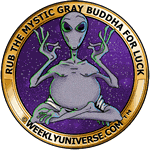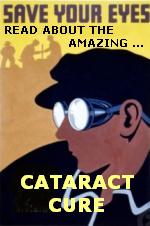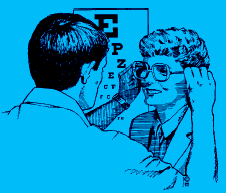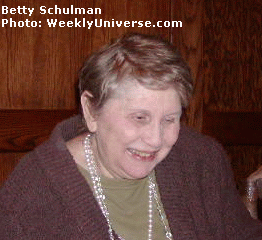Home
About Us
Bookstore
Links
Blog
Archives
Conspiracy Watch
Consumer Watchdog
Girls
In Black
Health
Heartwarmers
Paranormal
Quirky & Bizarre
UFOs
Weird
Science
Affilates
Hollywood Investigator
Horror Film Aesthetics
Horror Film Festivals
Horror Film Reviews
Tabloid Witch Awards







|
MIRACLE EYEDROP
DISSOLVES CATARACTS -- WITHOUT SURGERY!
by Thomas M. Sipos, managing editor.
[April 24, 2004]
[WeeklyUniverse.com]
A new miracle
eyedrop -- non-patented and available over-the-counter without
a prescription -- is dissolving cataracts!---
saving people from expensive and dangerous eye surgery -- and the FDA doesn't
want YOU to know about it!
 That's the shocking bombshell
revelation of libertarian sci-fi writer J. Neil Schulman and his mother
Betty, revealed in an exclusive interview
with the Weekly Universe on April 20, 2004, in Culver City, California. That's the shocking bombshell
revelation of libertarian sci-fi writer J. Neil Schulman and his mother
Betty, revealed in an exclusive interview
with the Weekly Universe on April 20, 2004, in Culver City, California.
The Schulmans' discovery
of this new miracle
eyedrop was sparked by the tragic result of Betty Schulman's
tragic first cataract surgery.
In 1997, Betty Schulman,
now 79, was diagnosed with cataracts. She was a poor candidate for
cataract surgery, as she was already suffering from thrombocytosis,
an elevated blood platelet count that may result in haemorrhaging or blood
clots if left untreated. Betty had been prescribed hydroxyurea to "control" her platelet count.
* Tragic First Surgery
By September 1999, Betty's right
eye
had worsened to the point that cataract surgery was unavoidable. Prior to surgery, her haematologist assured Betty that her platelet count
was currently normal, thanks to the hydroxyurea.
But tragically, despite
the assurances of modern medical science, Betty's eye surgery did not go
well. During surgery, clotting developed in the blood vessels feeding
the retina. The retina died within three to six minutes due to lack
of oxygen.
The next day, Betty was blind in her right eye. "It was like a curtain coming
down over my right eye," said Betty to
the Weekly Universe.
Even more tragically, the
cataract in her left eye continued to worsen. In December 2003, at
an eye exam at UCLA's Jules Stein Eye
Institute, Betty was told that if she didn't have cataract surgery in
her remaining good eye, she'd go blind in four to five years. Frighteningly,
she was given no guarantee that the same complication -- blood clotting
and
blindness -- would not reoccur. Her physician dare not overdose her
on hydroxyurea to control her platelet count, because that could lead to
fatal internal haemorrhaging.
* A Son's Outrage
J. Neil Schulman had accompanied
his mother to that eye exam, and he refused to accept the physician's dire
prognosis: eventual blindness through cataracts or possible blindness through
surgery. Neil demanded to know the physician's expertise, such as
when he'd last done a survey of cataract cures, and the physician admitted
that it had been four years.
"A lot can have happened
in four years!" Neil retorted. The physician did not appreciate
having his expertise questioned. "I'd really pissed him off," said
Neil to the Weekly Universe. "He finally threw up his hands and said,
okay, so do a search on Google. And that's just what I did!"
* The Miracle Eyedrop: N-Acetyl Carnosine
Arriving home, Neil googled "non-surgical
treatment of cataracts". He discovered that -- for several years
now! -- Europeans had been treating cataracts with a new miracle
eyedrop -- developed in Russia by Mark Babizhayev -- that dissolves cataracts!
The key ingredient is N-Acetyl
Carnosine -- a natural, non-controlled, non-patented enzyme. Because
it's a natural, non-controlled substance, it can be sold without a prescription,
over the counter. Because it's non-patented, several companies are
offering it in the US, keeping prices low due to free market competition.
However, because N-Acetyl Carnosine lacks FDA approval as a cataract cure,
the companies selling it are
wary of making claims for its being a cataract cure. The boxes
containing
the eyedrops only claim that the drops help "soothe tired eyes" -- and
they list N-Acetyl Carnosine as an "inactive ingredient."
Does it work? Does
N-Acetyl Carnosine dissolve cataracts?
Neil ordered N-Acetyl Carnosine
drops (which is sold in the US under several brand names, such as
Bright Eyes III and Can-C and Eye D'Clare), and Betty began
using them in the last week of December, 2003. Within three months,
she noticed an improvement in her left eye's vision.
"Before using the drops,
my cataract had gotten so bad, I could not distinguish faces on TV, I could
not read captions on TV, I had to use a magnifying glass to read my large-print
Reader's Digest, and I had trouble walking without bumping into things"
said Betty to the Weekly Universe. "But now, I can see where I'm
going. I can even read normal-sized text with just my regular glasses
-- no magnifying glass needed."
Even more amazingly, the
eyedrops have no negative side effects. The only downside Betty noticed
was that sometimes, for several hours after taking the
eyedrops, her vision
was blurry. This did not prevent the overall improvement of her vision.
"We believe that this momentary
bluriness is the cataract sloughing off, much as one
sloughs off a callous,"
Neil explained.
"Knowledge arrives unevenly,"
Neil added. "I realized that when I learned about Dr. Abraham Weber,
who took an aspirin a day to prevent strokes in the 1930s. He was
ahead of establishment medical science by some fifty years. That's
why I refused to believe the doctor who essentially told my mother she
had no choice but to go blind. And that doctor was wrong. The
eyedrops work!"
Copyright 2004 by WeeklyUniverse.com

| Dr.
Mark A. Babizhayev responds:
Your Information
about N-acetylcarnosine eyedrops was incorrect. N-acetylcarnosine
and its efficacious formulations have been patented by myself, worldwide. [Issued PCT Patent application: WO 2004/028536 A1]. My company, Innovative
Vision Products (IVP), holds the worldwide patents for the use of N-Acetylcarnosine
to address senile cataracts.
In addition
to our 1993 European Union patent application, we have filed
patent applications in the United States and additional
countries around the globe. The only
clinically efficacious Product on the market is Can-C TM available at Can-C.net and N-acetylcarnosine.com. Its Private labels Ocuzyme and Bionational (Nu-Eyes) are also clinically effective to cure cataracts.
I wish to
emphasize that there are serious potential risks to ocular health with
long term application of any preparation used in the eye, and therefore
usage should always be carefully considered and monitored by patients and
their physicians. A very fragile and highly specific balance of purity
for this formulation must be maintained to ensure safe and effective use
of N-Acetylcarnosine eyedrops. Only formulae made to this specific
purity and methodology, the patented formulae, have been proven in animal
and human clinical trials to be efficacious, and most importantly, safe
in long term use. Innovative
Vision Products (IVP) is the patent holder and the only maker of the clinically
proven N-Acetylcarnosine formula.
For public safety I established
IVP to ensure that the highest quality of standards are maintained for
formula production control. Unfortunately
there are a few amoral companies, attempting to capitalize on this discovery,
which are illicitly fabricating and touting inferior N-Acetylcarnosine
for senile cataracts without the benefit of the specific purity level and
methodology required to ensure efficacy and safety for eye use.
A
number of these deceptive companies are actually referencing my research
to promote their substandard product, thus damaging my reputation. Also,
some are attempting to make their products more attractive by adding vitamins
such as vitamin A and E. These vitamins, while by themselves may
be beneficial to the eye, on the other hand have branched hydrocarbon skeletons
that inhibit the activity of N-Acetylcarnosine, particularly in the critical
cornea and conjunctiva of the eye.
More importantly, combinations
of vitamins and N-Acetylcarnosine have not got any published clinical trials
for either efficacy or safety. This could lead to damage of the eye
surface with long term use, as was shown with L-Carnosine in our trials.
As the publisher of much research on this subject, I feel a responsibility
to inform consumers of the fraudulent and dangerous products being promoted
to the public. A simple
way to determine if one is purchasing the safe, patented formula product
is by the following statement, provided on the eyedrop labels by our approved
distributors: N-Acetylcarnosine Patented by Innovative Vision Products. This phrase ensures that you have the exact formula and purity of eyedrop
that was proven safe in our clinical trials.
For public
safety, we shall vigorously defend our patents and issue injunctions against
distributors of non-approved N-Acetylcarnosine anti-cataract eyedrops. We shall seek damages where appropriate. Sincerely,
Mark Babizhayev MA, PhD, Email: markbabizhayev2004@yahoo.com.
PS: All
published works about this issue in the peer reviewed Journals are originated
from this Group:
1. Babizhayev
MA, Deyev AI, Yermakova VN, Brikman IV, Bours J. Related Articles, Lipid peroxidation
and cataracts: N-acetylcarnosine as a therapeutic tool to manage age-related
cataracts in human and in canine eyes. Drugs R D. 2004;5(3):125-39.
PMID: 15139774 [PubMed - in process]
2: Babizhayev
MA, Nikolayev GM, Goryachev SN, Bours J, Martin R. Related Articles, Hydration
properties of the molecular chaperone alpha-crystallin in the bovine lens. Biochemistry (Mosc). 2003 Oct;68(10):1145-55. PMID: 14616086 [PubMed
- in process]
3: Babizhayev
MA, Deyev AI, Yermakova VN, Davydova NG, Kurysheva NI, Doroshenko VS, Zhukotskii
AV. Related Articles, Image analysis and glare sensitivity in human
age-related cataracts. Clin Exp Optom. 2003 May;86(3):157-72. PMID:
12767250 [PubMed - in process]
4: Babizhayev
MA. Related Articles, Links Glare disability and driving safety. Ophthalmic Res. 2003 Jan-Feb;35(1):19-25. PMID: 12566859 [PubMed - indexed
for MEDLINE]
5: Babizhayev
MA, Nikolayev GN, Goryachev SN, Bours J. Related Articles, NMR spin-echo
studies of hydration properties of the molecular chaperone alpha-crystallin
in
the bovine lens. Biochim Biophys Acta. 2002 Jul 29;1598(1-2):46-54.
PMID: 12147343 [PubMed - indexed for MEDLINE]
6: Babizhayev
MA, Deyev AI, Yermakova VN, Semiletov YA, Davydova NG, Doroshenko VS, Zhukotskii
AV, Goldman IM. Related Articles, Links Efficacy of N-acetylcarnosine
in the treatment of cataracts. Drugs R D. 2002;3(2):87-103. PMID:
12001824 [PubMed - indexed for MEDLINE]
7: Babizhayev
MA, Deyev AI, Yermakova VN, Semiletov YA, Davydova NG, Kurysheva NI, Zhukotskii
AV, Goldman IM. Related Articles, Links N-Acetylcarnosine, a natural histidine-
containing dipeptide, as a potent ophthalmic drug in treatment of human
cataracts. Peptides. 2001 Jun;22(6):979-94. PMID: 11390029
[PubMed - indexed for MEDLINE]
8: Babizhayev
MA, Yermakova VN, Semiletov YA, Deyev AI. Related Articles, The natural
histidine-containing dipeptide Nalpha-acetylcarnosine as an antioxidant
for ophthalmic use. Biochemistry (Mosc). 2000 May;65(5):588-98.
PMID: 10851037 [PubMed - indexed for MEDLINE]
9: Babizhayev
MA, Semiletov YA, Lul'kin YA, Sakina NL, Savel'yeva EL, Deyev AI, Alimbarova
LI, Barinskii IF, Nicolay J, Paillet C, Langrand G, Seguin F. Related Articles,
Cellular signalling and free-radical modulating activities of the novel
peptidomimetic L-glutamyl-histamine.Biochemistry (Mosc). 1999 May;64(5):510-22.
PMID: 10381611 [PubMed - indexed for MEDLINE]
10: Babizhayev
MA, Lozovskaya EL, Makareyeva EN, Lul'kin YA, Sapezhinskii II. Related
Articles, Photoprotector and antioxidant properties of histamine-containing
peptidomimetics in the photooxidation of glycyltryptophan.Biochemistry
(Mosc). 1998 May;63(5):523-8. PMID: 9632886 [PubMed - indexed
for MEDLINE]
11: Babizhayev
MA, Yermakova VN, Sakina NL, Evstigneeva RP, Rozhkova EA, Zheltukhina GA.
Related Articles, N alpha-acetylcarnosine is a prodrug of L-carnosine in
ophthalmic application as antioxidant.Clin Chim Acta. 1996 Oct 15;254(1):1-21. Erratum in: Clin Chim Acta 1997 Mar 18;259(1-2):199-201. PMID: 8894306
[PubMed - indexed for MEDLINE]
12: Babizhayev
MA.
Related Articles, Failure to withstand oxidative stress induced by phospholipid
hydroperoxides as a possible cause of the lens opacities in systemic diseases
and ageing. Biochim Biophys Acta. 1996 Mar 1;1315(2):87-99. PMID:
8608175 [PubMed - indexed for MEDLINE]
13: Babizhayev
MA, Bours J, Utikal KJ. Related Articles, Isoelectric focusing of crystallins
in microsections of calf and adult bovine lens. Identification of
water-insoluble crystallins complexing under nondenaturing conditions:
demonstration of chaperone activity of alpha-crystallin. Ophthalmic
Res. 1996;28(6):365-74. PMID: 9032796 [PubMed - indexed for MEDLINE] |
| A reader, Parhatsathid,
responds:
Actually Betty Schulman's cataract
was caused by hydroxyurea supplements. Backing that off a bit would
stop the cataract within 6 days. So while N Acetyl Carnosine might
be helpful, in vitro tests showed that hydroxyurea was the cause and can
reverse the cataract.
Tokai journal of experimental
and clinical medicine, Vol.6, No.3(19810700) pp. 321-326, ISSN:03850005,
Histopathology of Reversible Cataracts Produced by Hydroxyurea in vitro,
MIKUNI
Ikuo 1, 1Department of Ophthalmology, School of Medicine, Tokai University Hydroxyurea Epithel Cataract Rat A DNA synthesis inhibitor, hydroxyurea
(HU) (5×10^M), was added to the organ culture medium for a rat crystalline
lens (male, white Wistar rats weighing 100g).
1. On the 3rd day, a macroscopic
examination revealed diffuse opacity of the posterior capsule. Because
of
removal of HU from the culture medium on the 3rd day the crystalline lens
had become lucid on the 6th day, approximately the same as that of the
control of the 6th day. In a histopathological examination, the epithelial
cells appeared to maintain a histo-architecture similar to that of the
control. Lens fiber swelling was scarce at this time.
2. The crystalline lens cultured
with HU showed diffuse opacity of the anterior capsule and localized opacity
below the posterior capsule in a macroscopic examination on the 5th day. In histopathological examinations of the same culture, the lens epithelial
cells and swelling of the lens fibers had disappeared.
[Posted October 21, 2007] |
|
